Admin¶
Tooling Admin is used to add and maintain Unplanned Maintenance Reasons, Planned Maintenance Reasons, Tool Types, Tool Storage Locations, Tooling Checklist Items, and Tooling Item Categories.
To view Tooling Admin, navigate to the  tab and click on the
tab and click on the ![]() icon. The Tooling Admin screen will be displayed.
icon. The Tooling Admin screen will be displayed.
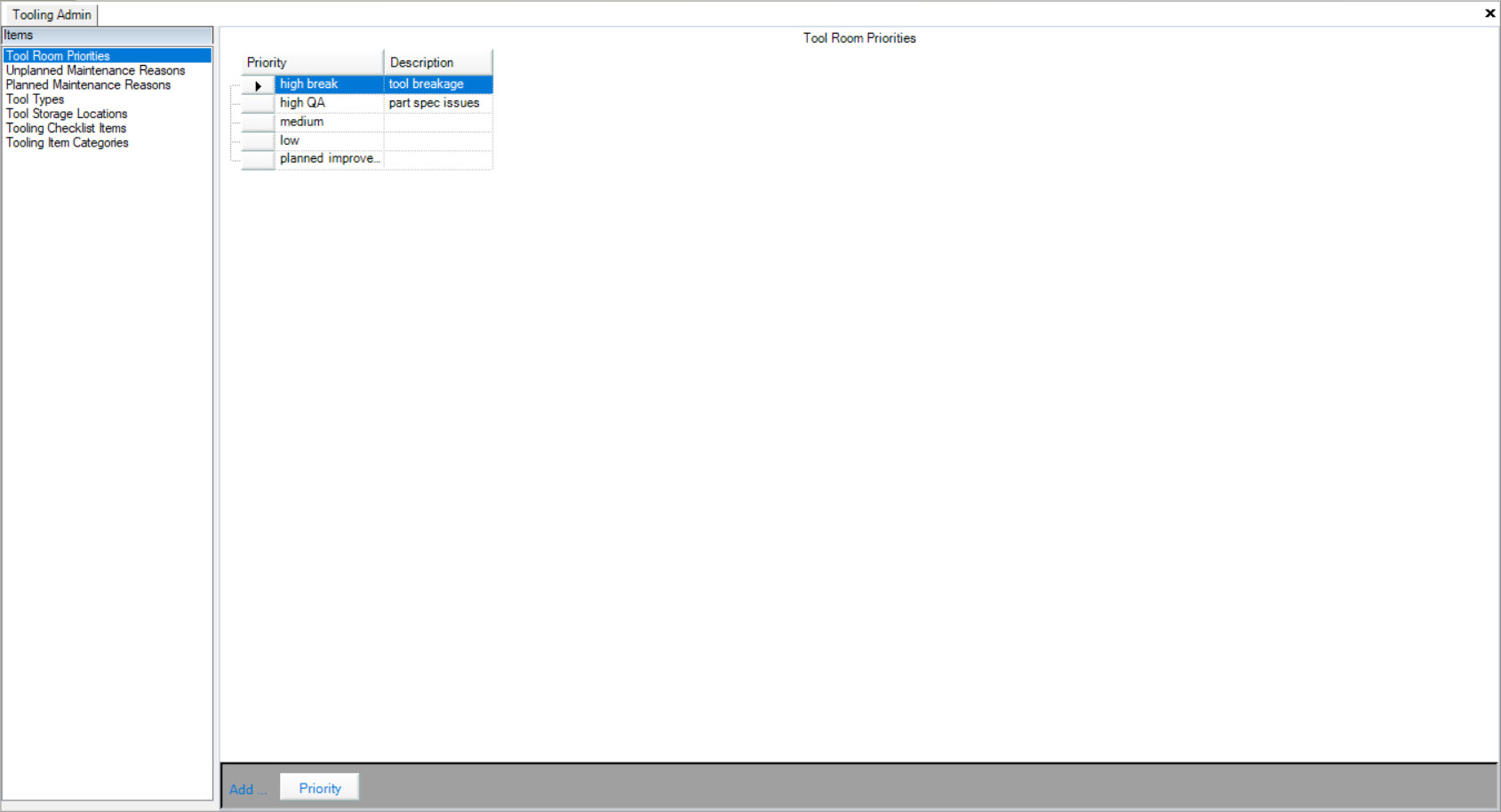
Unplanned Maintenance Reasons¶
Unplanned Maintenance Reasons will show in the drop-down menu when Tooling Work Order Requests or Unplanned Work Orders are created in the system.
To view Unplanned Maintenance Reasons, navigate to the  tab and click on the
tab and click on the ![]() icon. The Tooling Admin screen will be displayed.
icon. The Tooling Admin screen will be displayed.

Make sure to select Unplanned Maintenance Reasons located below the Items pane to the left of the screen.
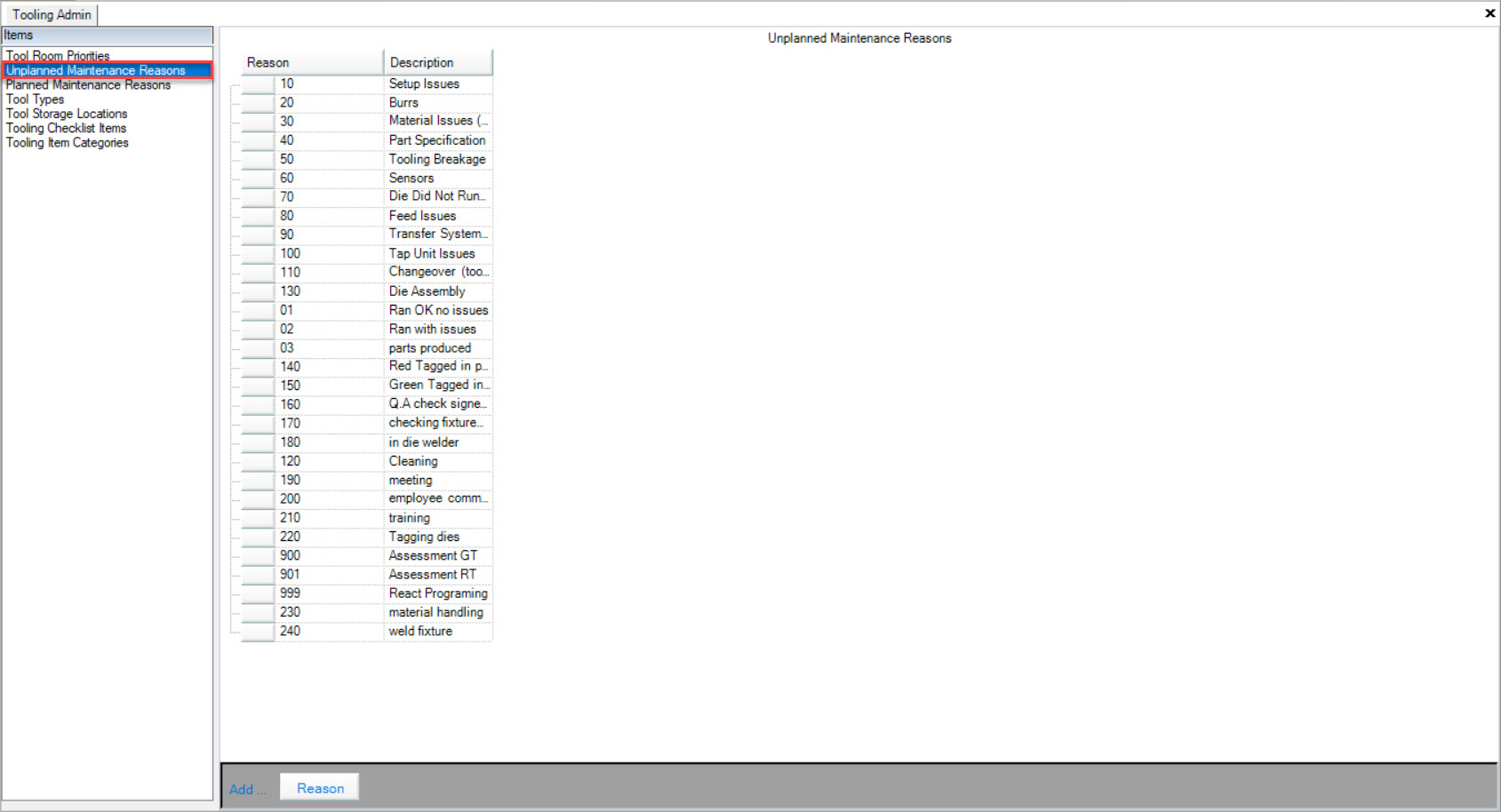
All of the Unplanned Maintenance Reasons in the system will be displayed.
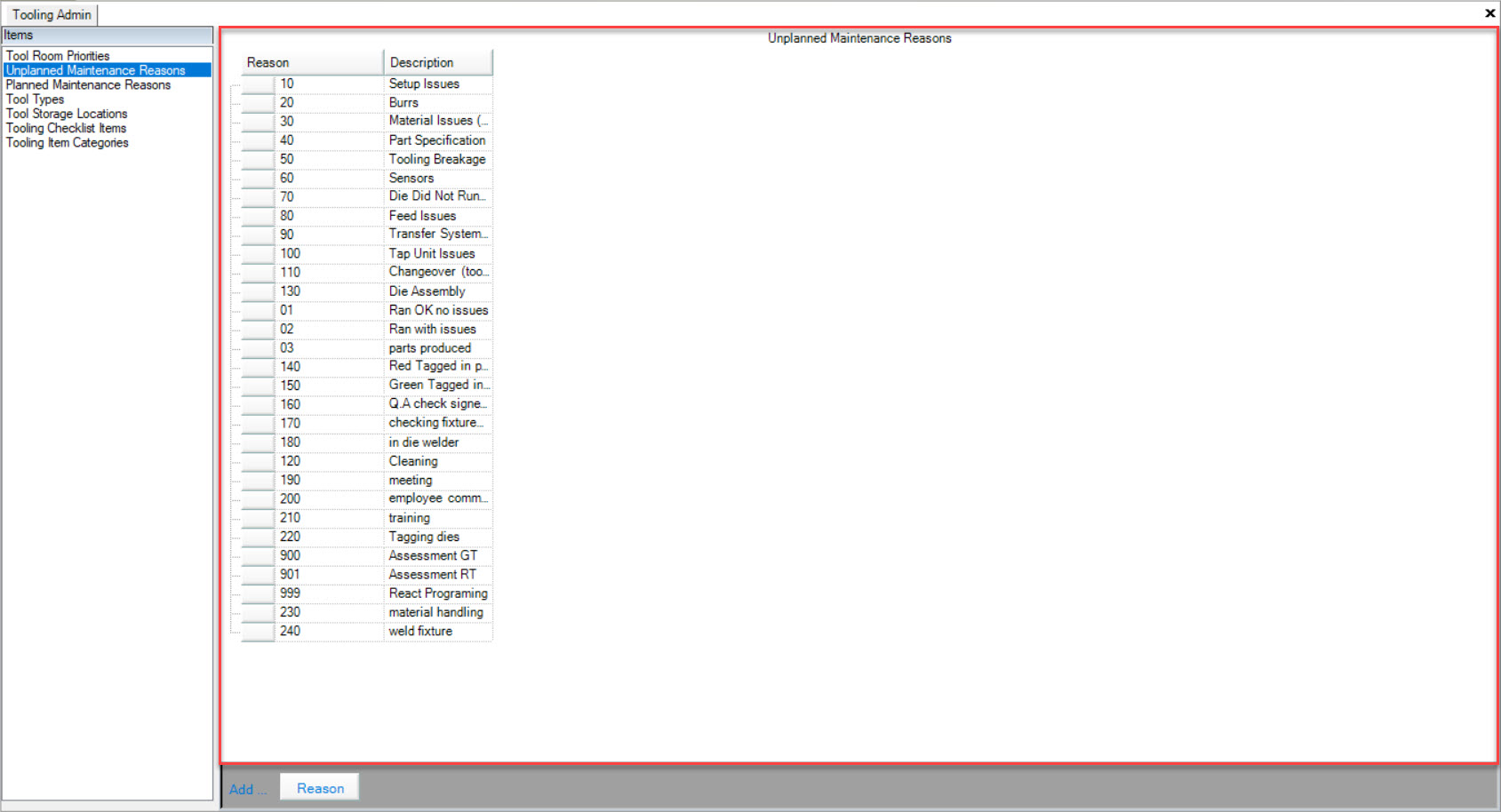
Here, users are able to add, edit, or delete Unplanned Maintenance Reasons.
Adding an Unplanned Maintenance Reason¶
To add an Unplanned Maintenance Reason, navigate to the  tab and click on the
tab and click on the ![]() icon. The Tooling Admin screen will be displayed.
icon. The Tooling Admin screen will be displayed.

Make sure to select Unplanned Maintenance Reasons located below the Items pane to the left of the screen.

Then, click on the  button located at the bottom of the screen.
button located at the bottom of the screen.
A new row will appear where users must enter in the Reason and Description using the available textboxes.
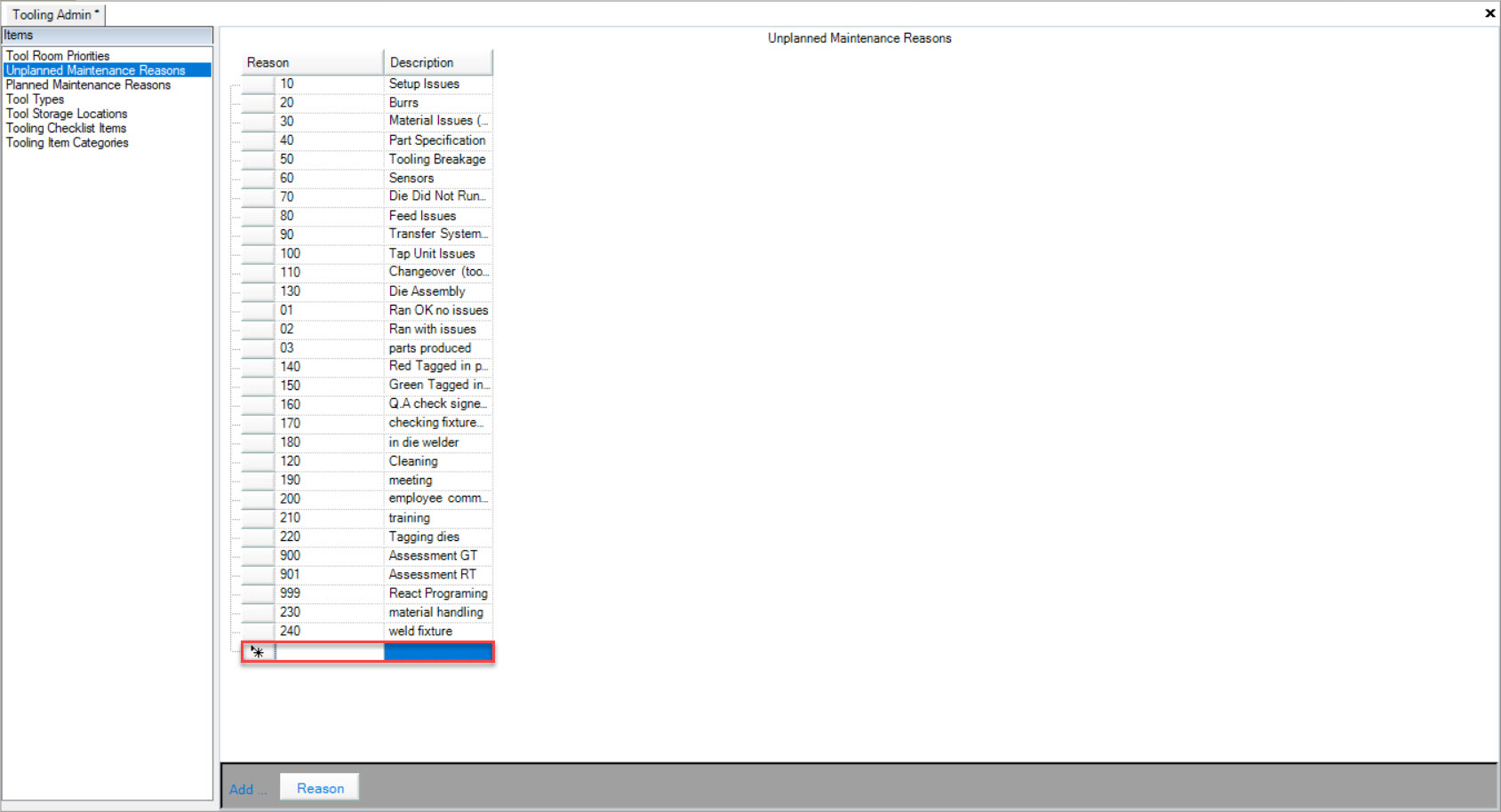
Make sure to save your changes before exiting the screen.
Editing an Unplanned Maintenance Reason¶
To edit an Unplanned Maintenance Reason, navigate to the  tab and click on the
tab and click on the ![]() icon. The Tooling Admin screen will be displayed.
icon. The Tooling Admin screen will be displayed.

Make sure to select Unplanned Maintenance Reasons located below the Items pane to the left of the screen.

Locate the Unplanned Maintenance Reason you wish to edit and make the necessary changes using the available textboxes.
Make sure to save your changes before exiting the screen.
Deleting an Unplanned Maintenance Reason¶
To delete an Unplanned Maintenance Reason, navigate to the  tab and click on the
tab and click on the ![]() icon. The Tooling Admin screen will be displayed.
icon. The Tooling Admin screen will be displayed.

Make sure to select Unplanned Maintenance Reasons located below the Items pane to the left of the screen.

Locate the Unplanned Maintenance Reason you wish to delete and highlight the appropriate row. Use your Delete key and when the system prompts you, select Yes.
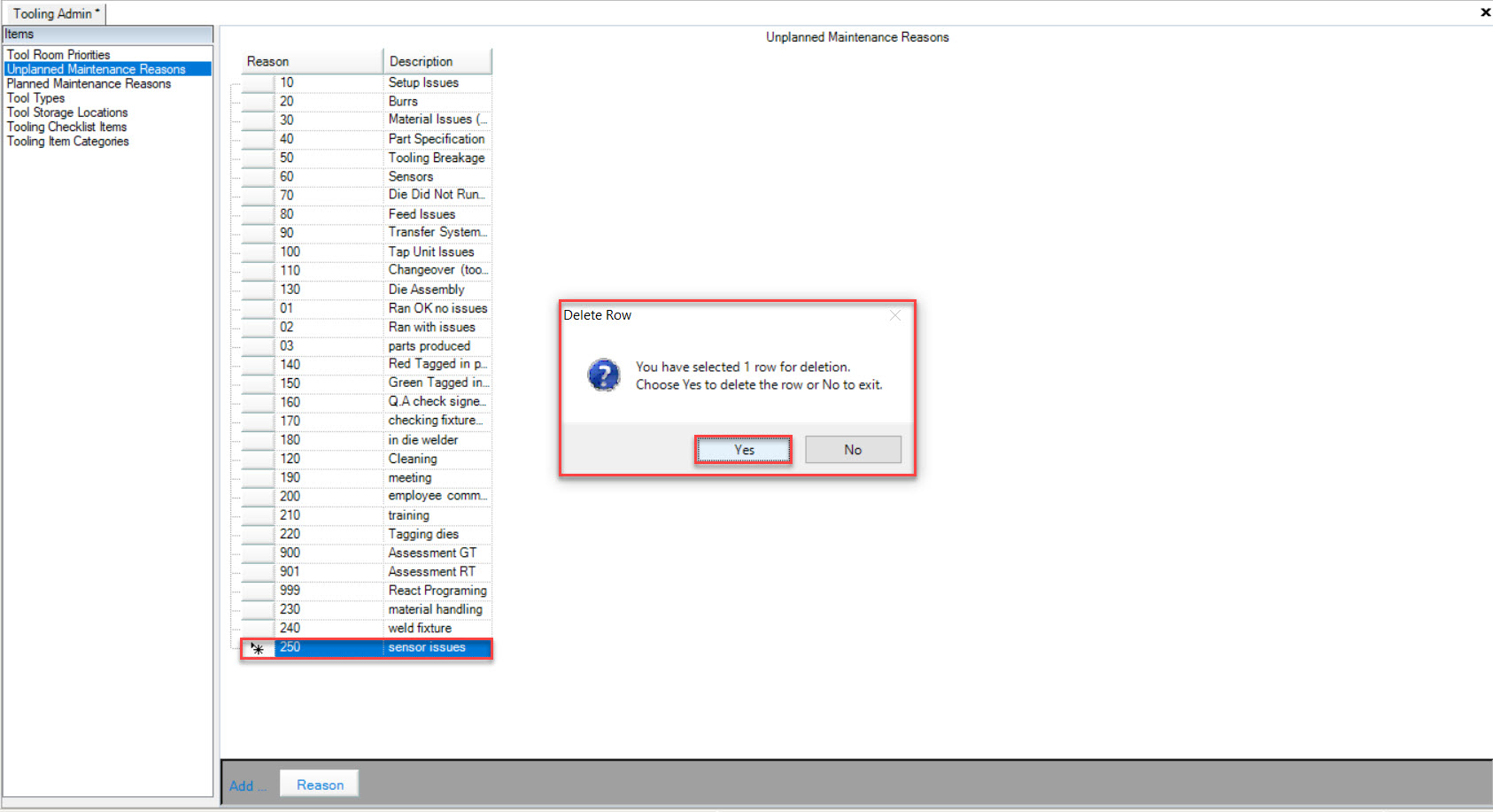
The selected Unplanned Maintenance Reason will be deleted. Make sure to save your changes before exiting the screen.
Planned Maintenance Reasons¶
Planned Maintenance Reasons will show in the drop-down menu as an option when users create Planned Maintenance on the Tooling Item screen.
To view Planned Maintenance Reasons, navigate to the  tab and click on the
tab and click on the ![]() icon. The Tooling Admin screen will be displayed.
icon. The Tooling Admin screen will be displayed.

Make sure to select Planned Maintenance Reasons located below the Items pane to the left of the screen.
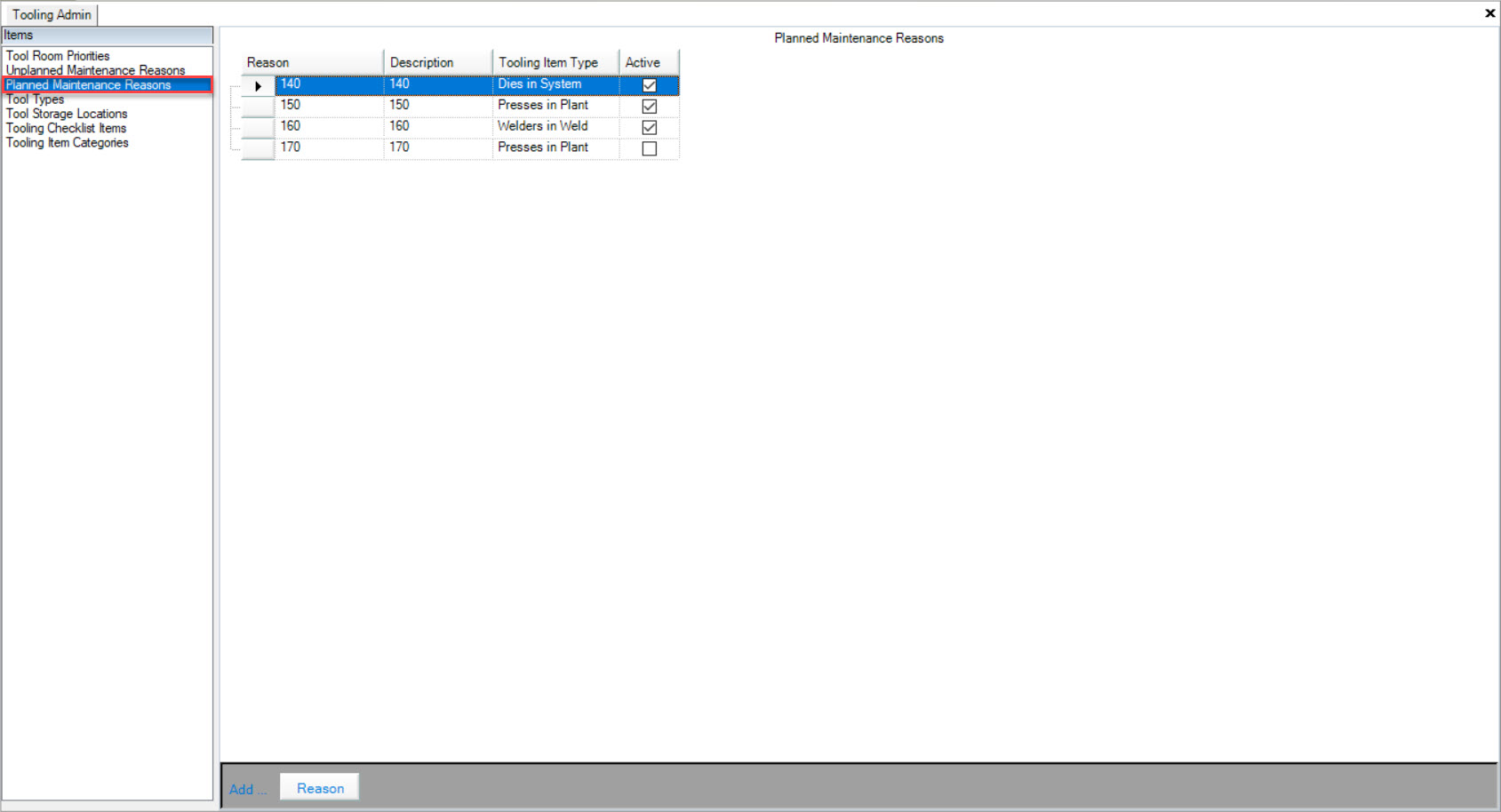
All of the available Planned Maintenance Reasons in the system will be displayed.
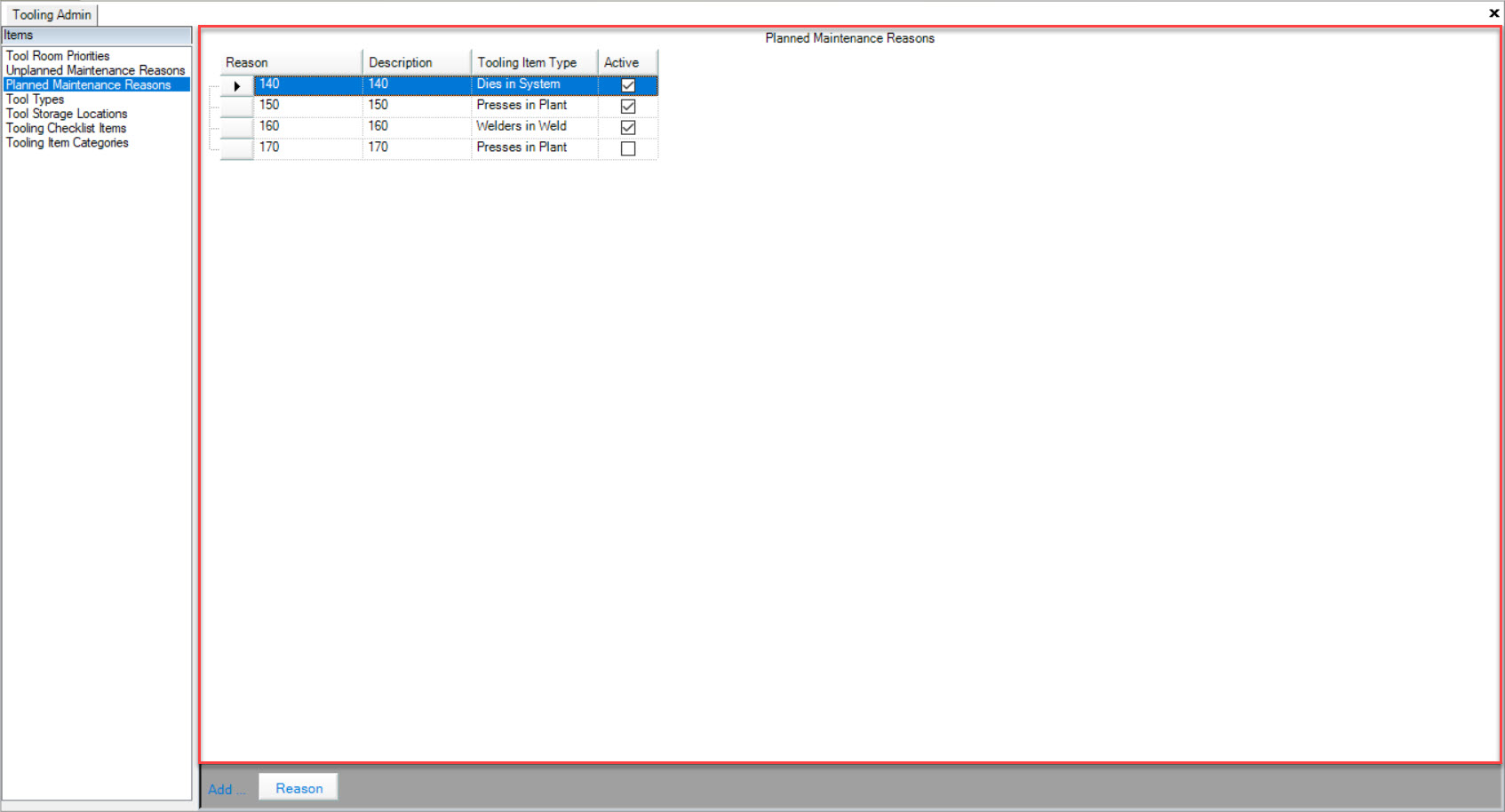
Here, users are able to add, edit, or delete Planned Maintenance Reasons.
Adding a Planned Maintenance Reason¶
To add a Planned Maintenance Reason, navigate to the  tab and click on the
tab and click on the ![]() icon. The Tooling Admin screen will be displayed.
icon. The Tooling Admin screen will be displayed.

Make sure to select Planned Maintenance Reasons located below the Items pane to the left of the screen.

Then, click on the  button located at the bottom of the screen.
button located at the bottom of the screen.
A new row will appear where users must enter in the Reason and Description, select a Tooling Item Type if you like using the drop-down menu, and check whether or not it will be Active (it will automatically default to Active, but users can override this by de-selecting the checkbox).
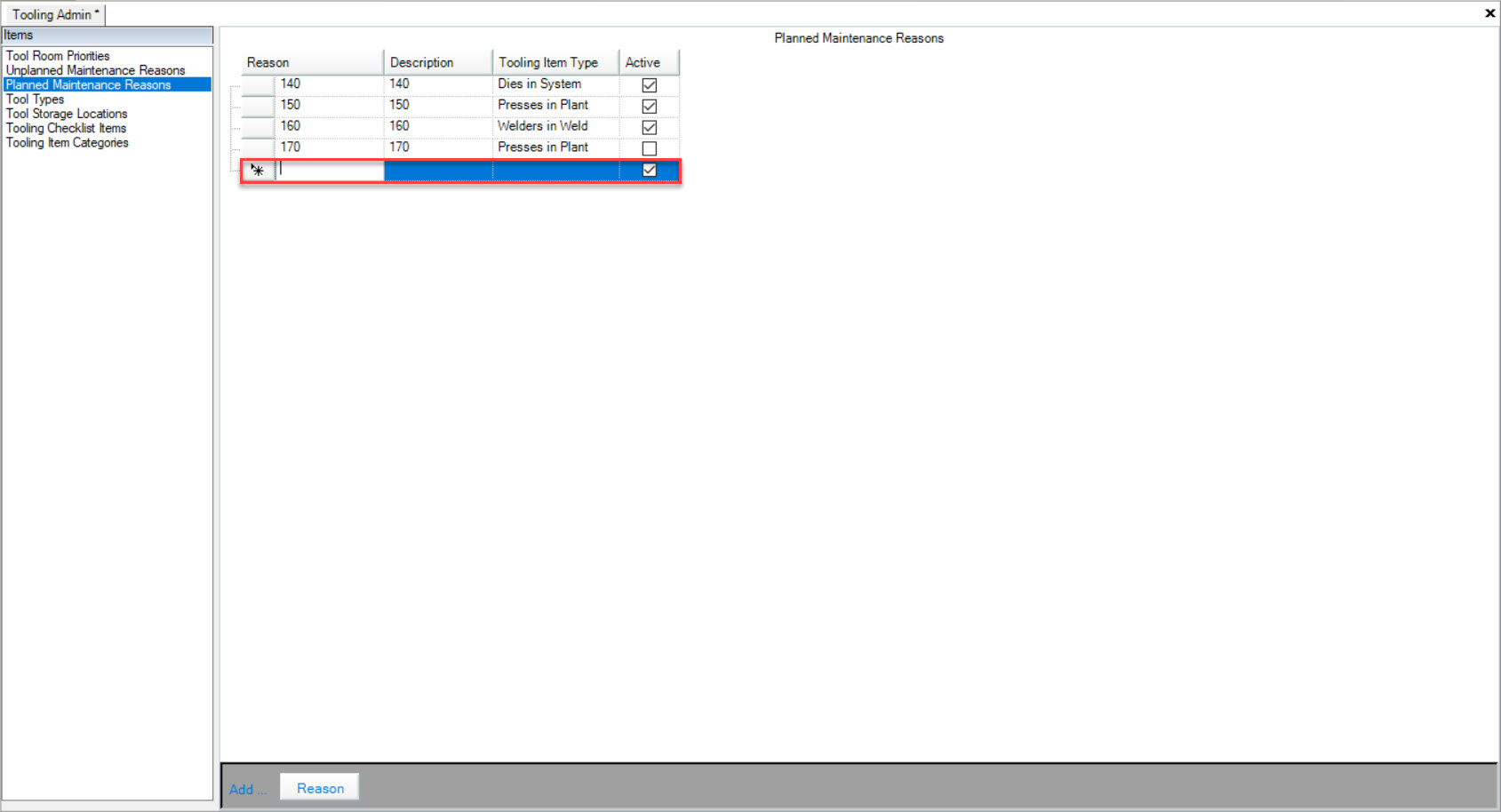
Make sure to save your changes before exiting the screen.
Editing a Planned Maintenance Reason¶
To edit a Planned Maintenance Reason, navigate to the  tab and click on the
tab and click on the ![]() icon. The Tooling Admin screen will be displayed.
icon. The Tooling Admin screen will be displayed.

Make sure to select Planned Maintenance Reasons located below the Items pane to the left of the screen.

Locate the Planned Maintenance Reason you wish to edit and make the necessary changes using the available textboxes, drop-down menu, and checkbox.
Make sure to save your changes before exiting the screen.
Deleting a Planned Maintenance Reason¶
To delete a Planned Maintenance Reason, navigate to the  tab and click on the
tab and click on the ![]() icon. The Tooling Admin screen will be displayed.
icon. The Tooling Admin screen will be displayed.

Make sure to select Planned Maintenance Reasons located below the Items pane to the left of the screen.

Locate the Planned Maintenance Reason you wish to delete and highlight the appropriate row. Use your Delete key and when the system prompts you, select Yes.
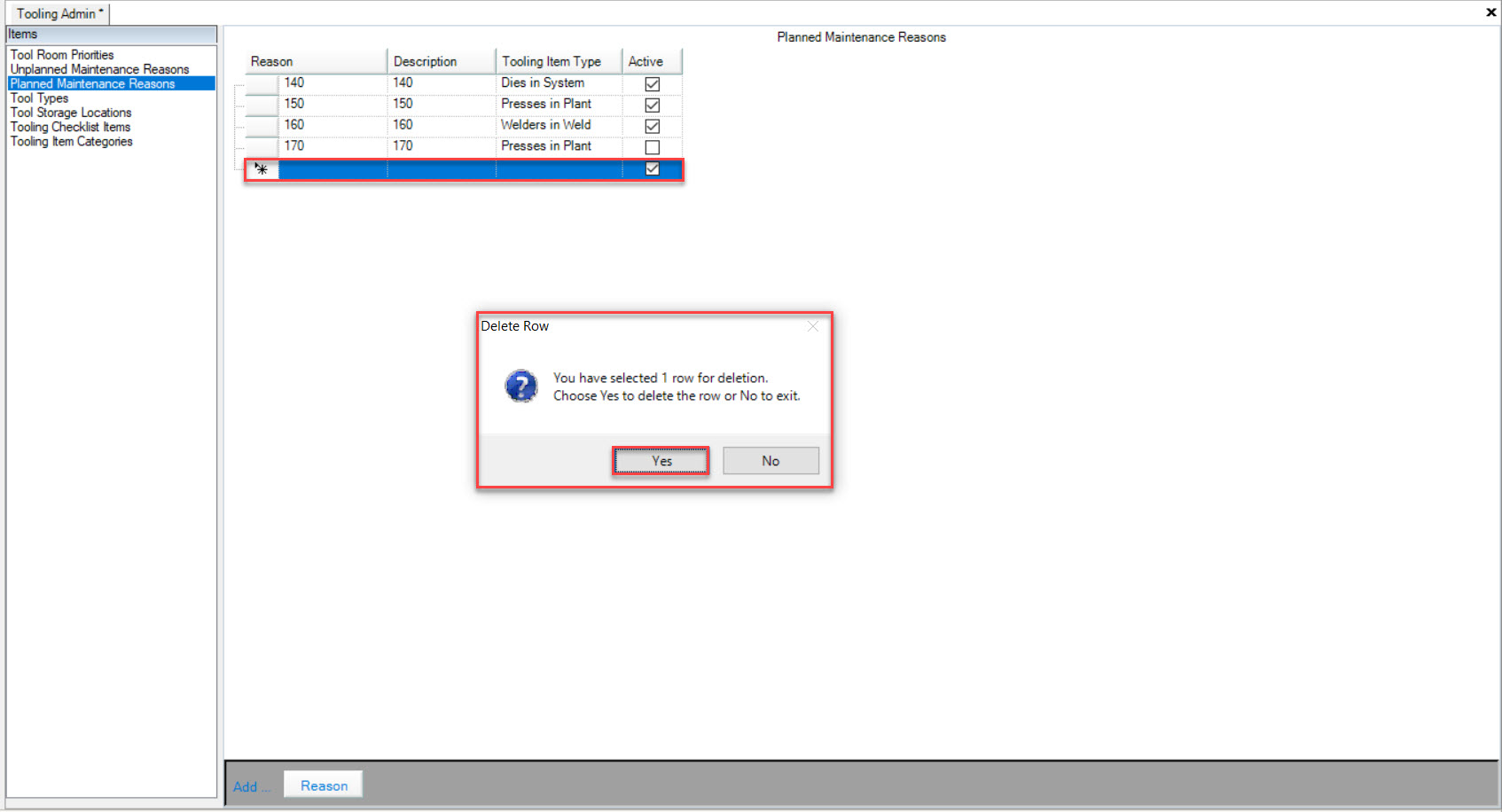
The selected Planned Maintenance Reason will be deleted. Make sure to save your changes before exiting the screen.
Tool Types¶
Tool Types will appear as a drop-down option on the Tooling Item screen where users must select from.
To view Tool Types, navigate to the  tab and click on the
tab and click on the ![]() icon. The Tooling Admin screen will be displayed.
icon. The Tooling Admin screen will be displayed.

Make sure to select Tool Types located below the Items pane to the left of the screen.
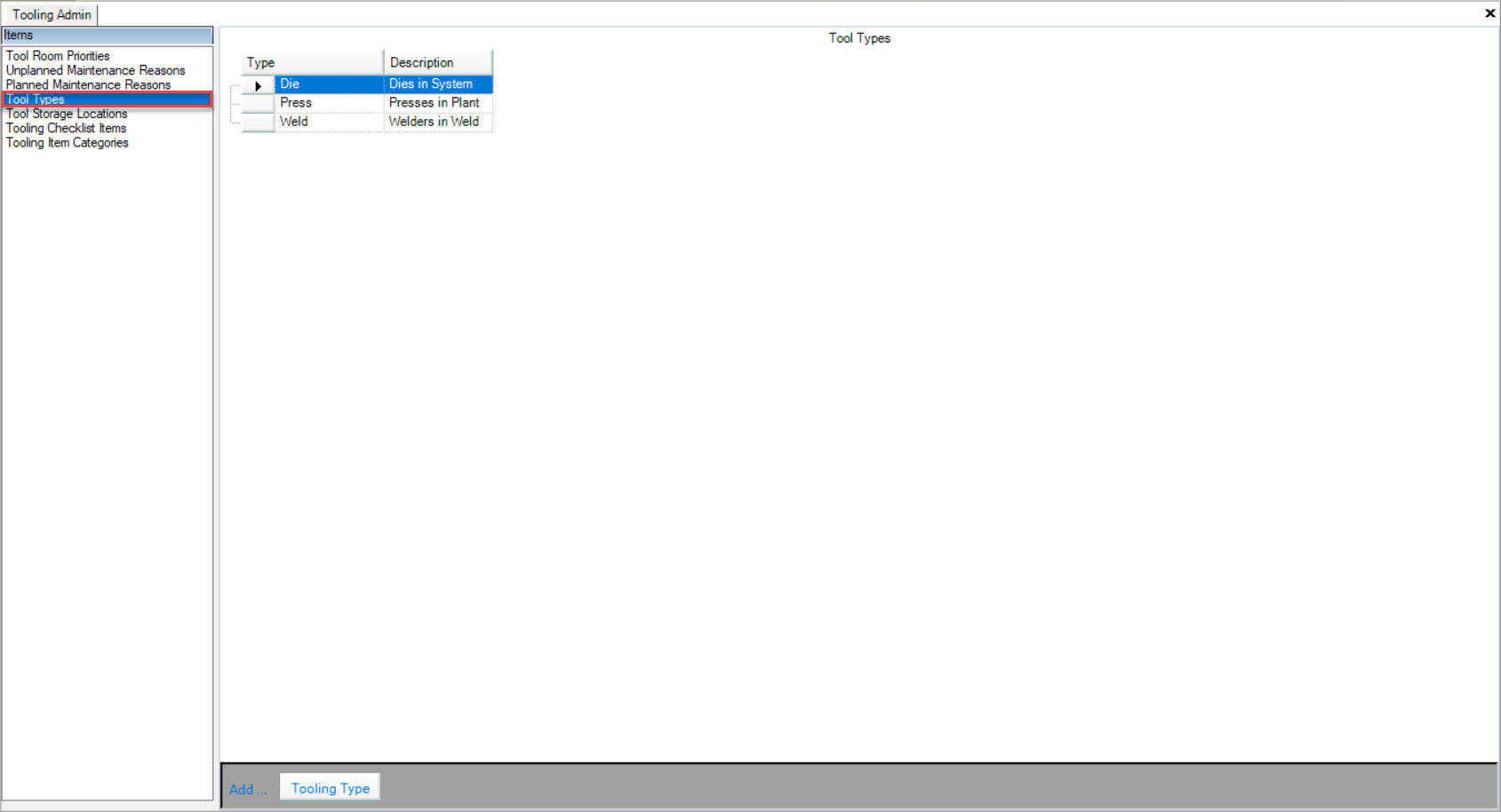
All of the available Tool Types in the system will be displayed.
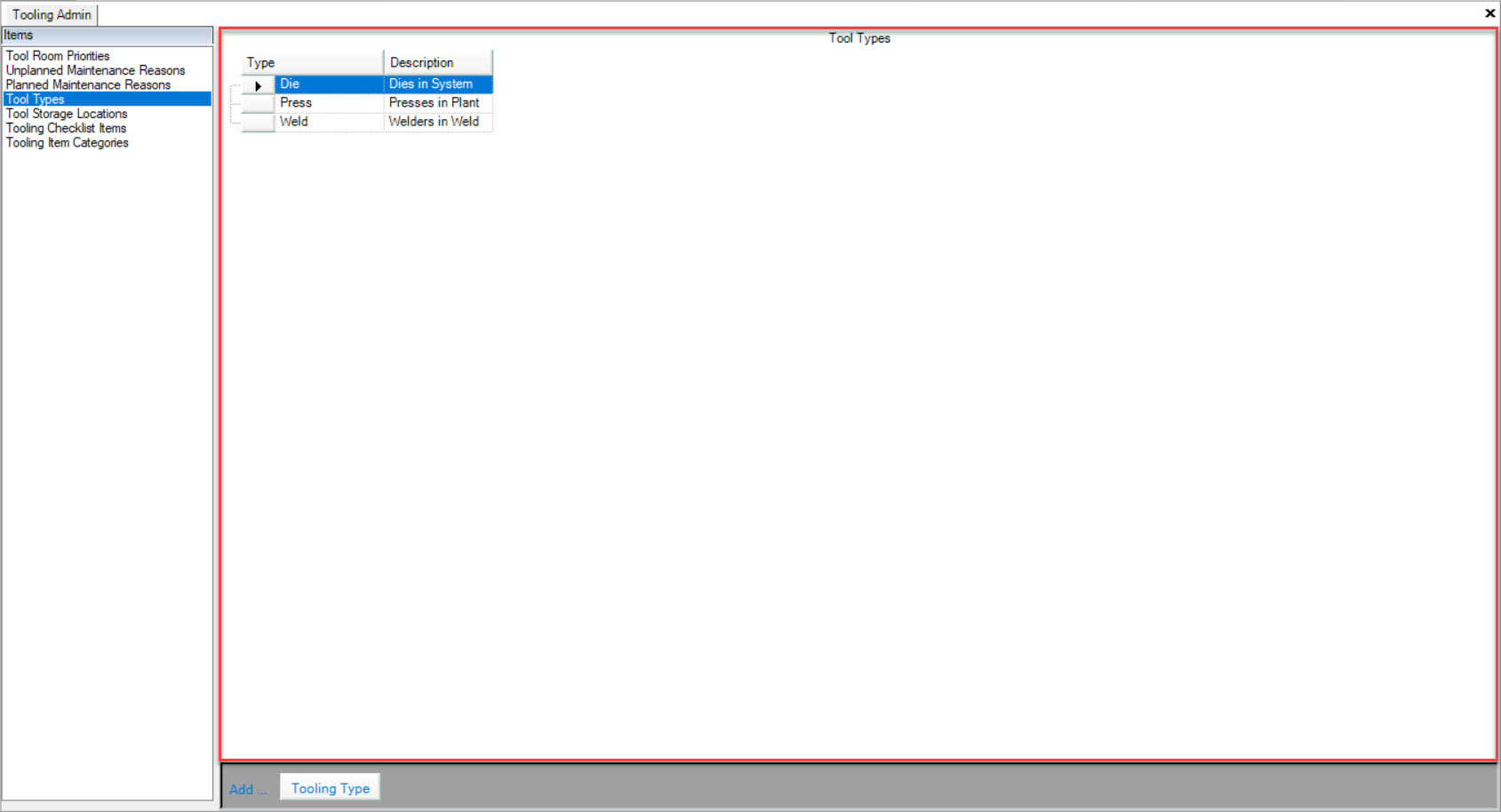
Here, users are able to add, edit, or delete Tool Types.
Adding a Tool Type¶
To add a Tool Type, navigate to the  tab and click on the
tab and click on the ![]() icon. The Tooling Admin screen will be displayed.
icon. The Tooling Admin screen will be displayed.

Make sure to select Tool Types located below the Items pane to the left of the screen.

Then, click on the  button located at the bottom of the screen.
button located at the bottom of the screen.
A new row will appear where users must enter in the Type and Description using the available textboxes.
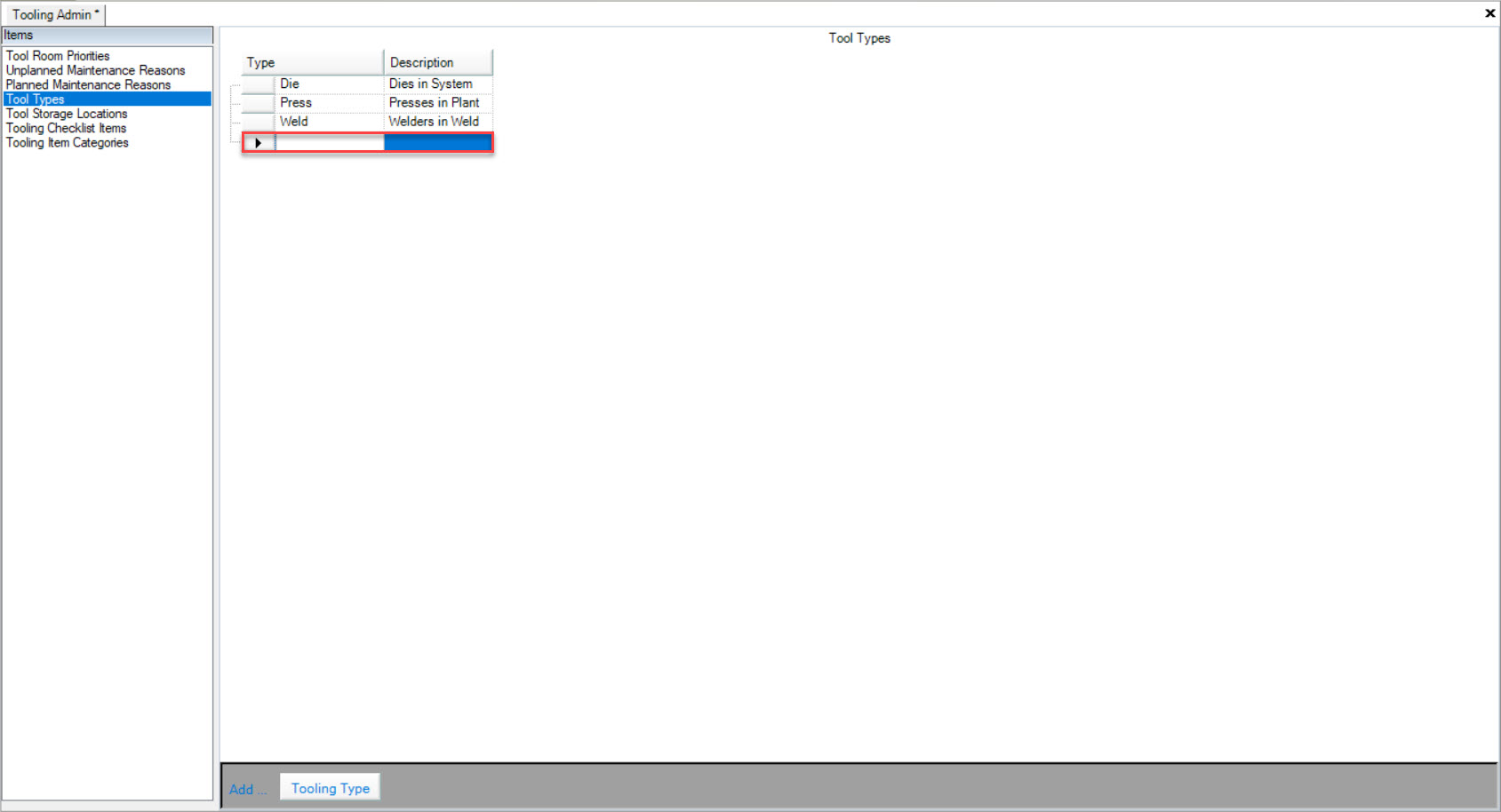
Make sure to save your changes before exiting the screen.
Editing a Tool Type¶
To edit a Tool Type, navigate to the  tab and click on the
tab and click on the ![]() icon. The Tooling Admin screen will be displayed.
icon. The Tooling Admin screen will be displayed.

Make sure to select Tool Types located below the Items pane to the left of the screen.

Locate the Tool Type you wish to edit and make the necessary changes using the available textboxes.
Make sure to save your changes before exiting the screen.
Deleting a Tool Type¶
To delete a Tool Type, navigate to the  tab and click on the
tab and click on the ![]() icon. The Tooling Admin screen will be displayed.
icon. The Tooling Admin screen will be displayed.

Make sure to select Tool Types located below the Items pane to the left of the screen.

Locate the Tool Type you wish to delete and highlight the appropriate row. Use your Delete key and when the system prompts you, select Yes.
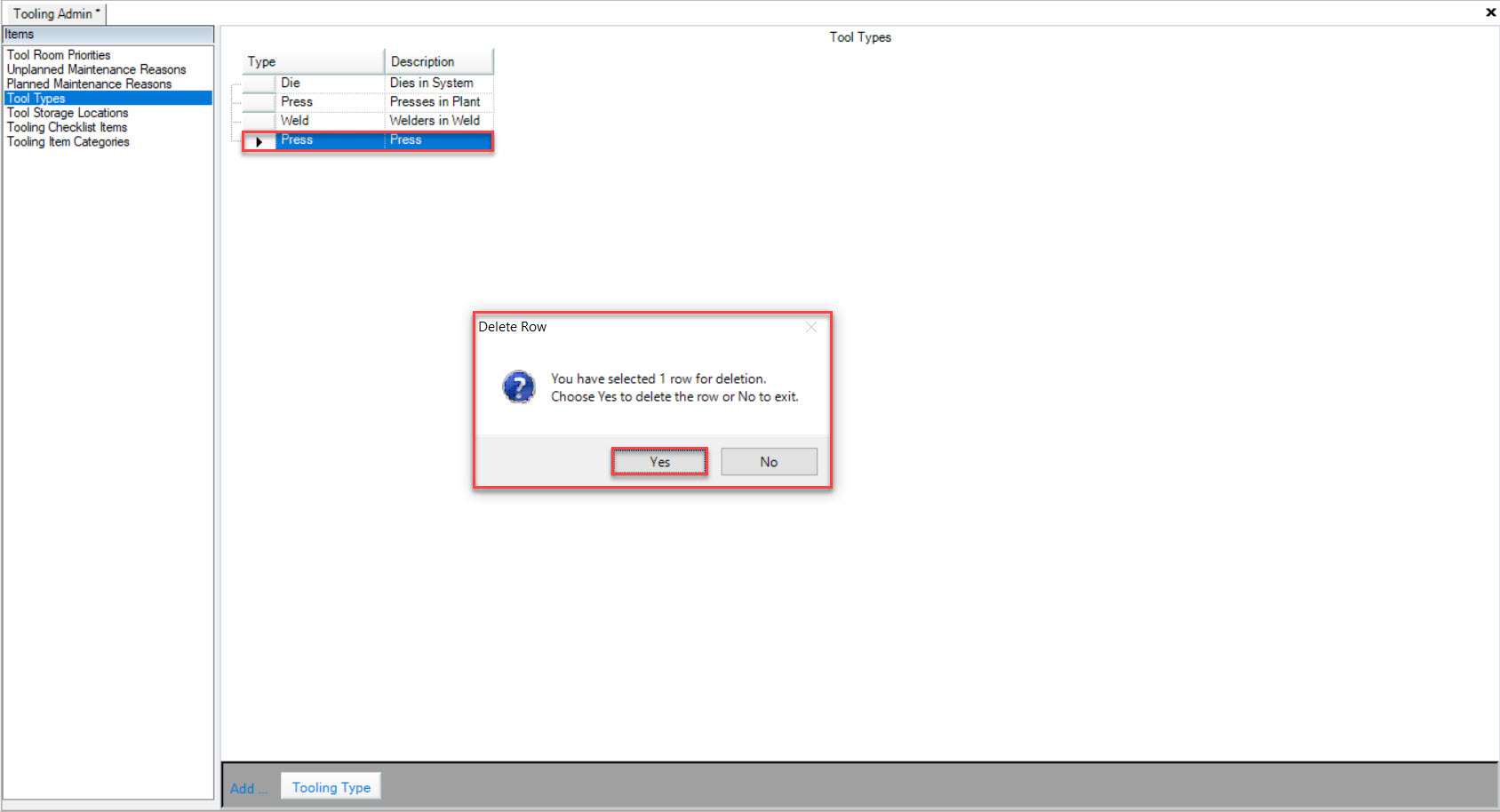
The selected Tool Type will be deleted. Make sure to save your changes before exiting the screen.
Tool Storage Locations¶
Tool Storage Locations can be added to the system to keep track of the location of Tooling Items.
To view Tool Storage locations, navigate to the  tab and click on the
tab and click on the ![]() icon. The Tooling Admin screen will be displayed.
icon. The Tooling Admin screen will be displayed.

Make sure to select Tool Storage Locations located below the Items pane to the left of the screen.
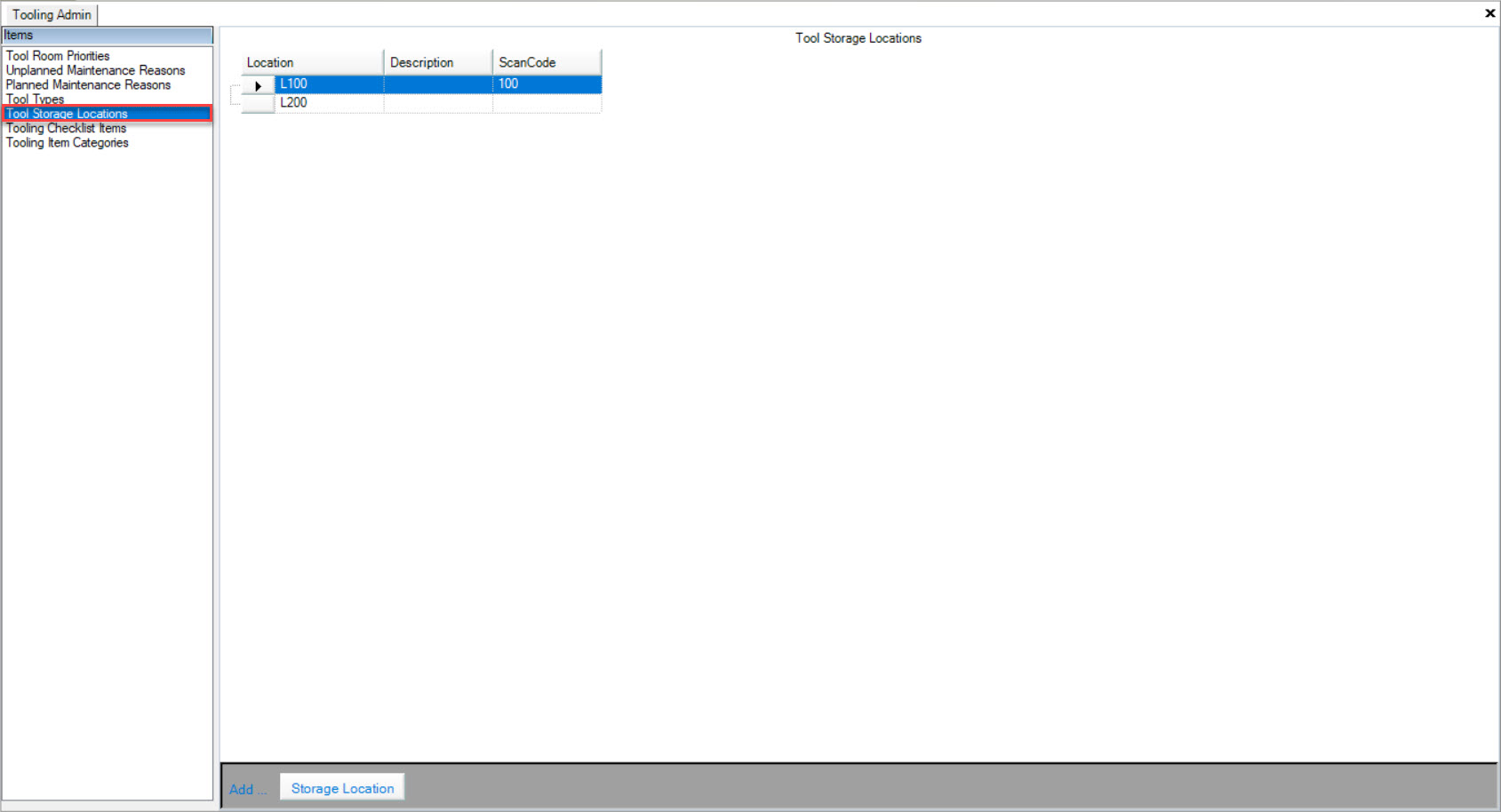
All of the available Tool Storage Locations in the system will be displayed.
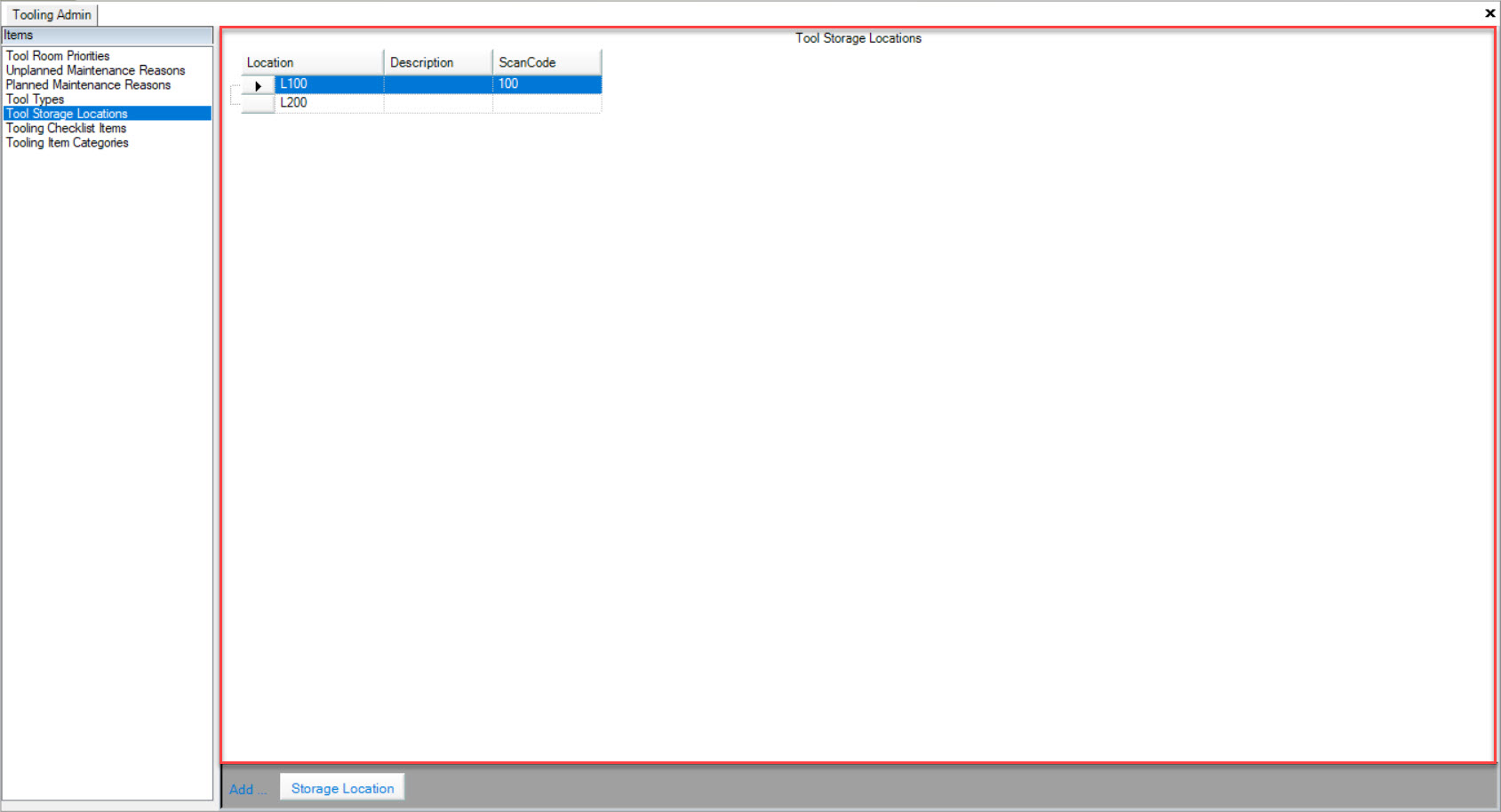
Here, users will be able to add, edit, or delete Tool Storage Locations.
Adding a Tool Storage Location¶
To add a Tooling Storage Location, navigate to the  tab and click on the
tab and click on the ![]() icon. The Tooling Admin screen will be displayed.
icon. The Tooling Admin screen will be displayed.

Make sure to select Tool Storage Locations located below the Items pane to the left of the screen.

Then, click on the  button located at the bottom of the screen.
button located at the bottom of the screen.
A new row will appear where users must enter in the Location, Description, and Scan Code using the available textboxes.
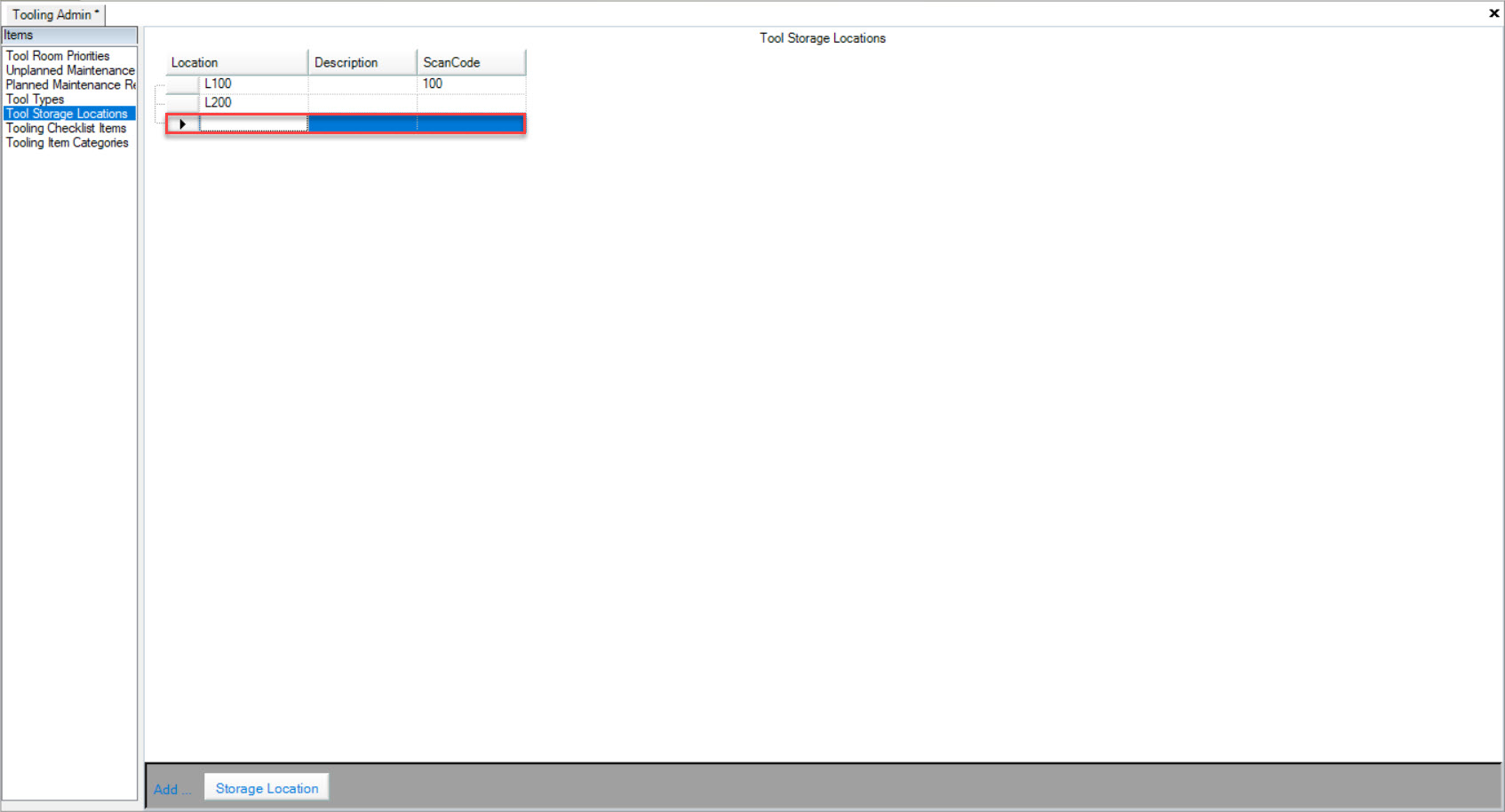
Make sure to save your changes before exiting the screen.
Editing a Tool Storage Location¶
To edit a Tool Storage Location, navigate to the  tab and click on the
tab and click on the ![]() icon. The Tooling Admin screen will be displayed.
icon. The Tooling Admin screen will be displayed.

Make sure to select Tool Storage Locations located below the Items pane to the left of the screen.

Locate the Tool Storage Location you wish to edit and make the necessary changes using the available textboxes.
Make sure to save your changes before exiting the screen.
Deleting a Tool Storage Location¶
To delete a Tool Storage Location, navigate to the  tab and click on the
tab and click on the ![]() icon. The Tooling Admin screen will be displayed.
icon. The Tooling Admin screen will be displayed.

Make sure to select Tool Storage Locations located below the Items pane to the left of the screen.

Locate the Tool Storage Location you wish to delete and highlight the appropriate row. Use your Delete key and when the system prompts you, select Yes.
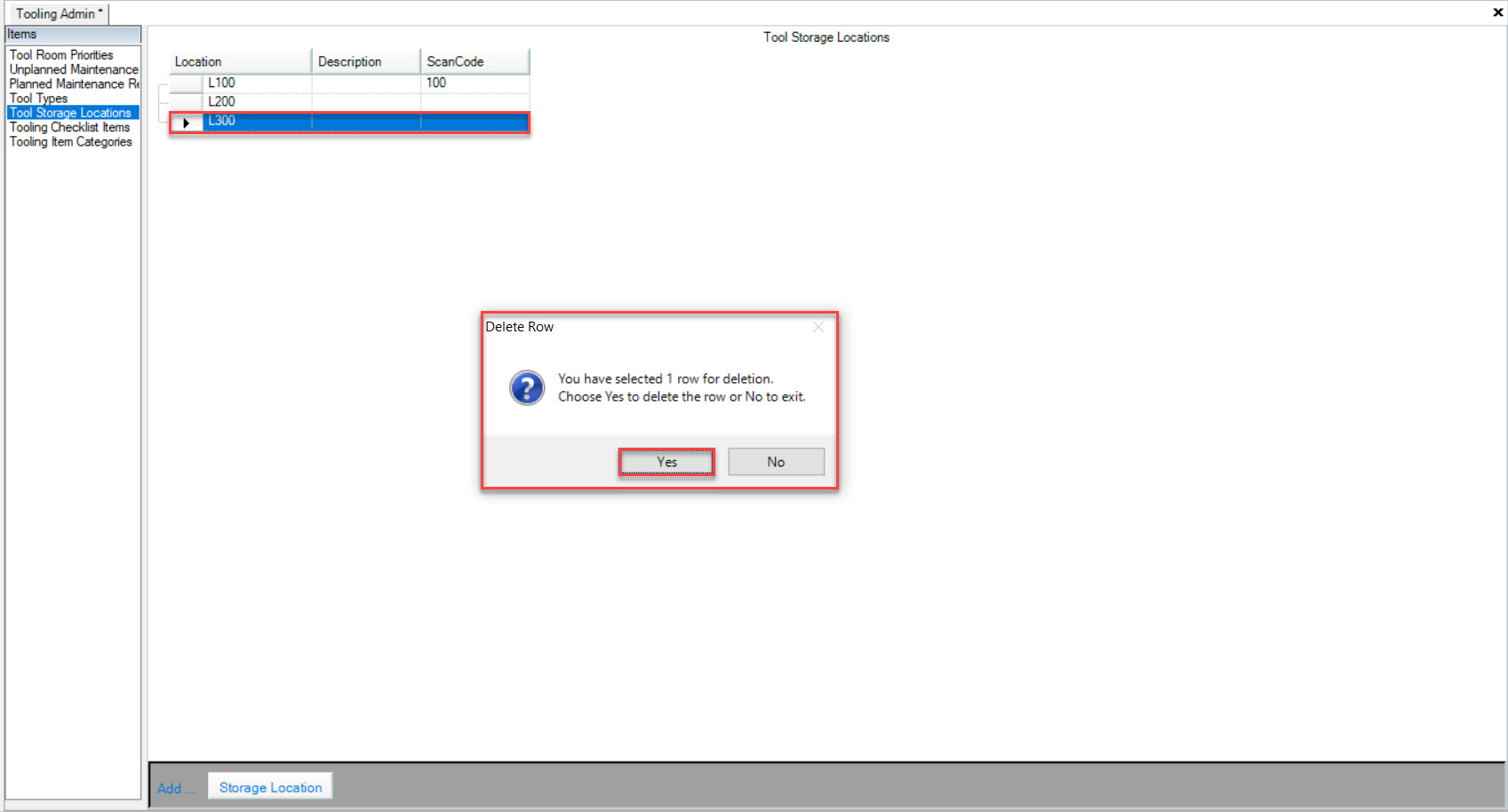
The selected Tool Storage Location will be deleted. Make sure to save your changes before exiting the screen.
Tooling Checklist Items¶
Tooling Checklist Items show on the End Job window after Operators click the End Job button on the Operator Schedule screen.
allow users to enter information that will show on a Checklist by Workcenter Type when ending a Job on the Operator Schedule.
To view Tooling Checklist Items, navigate to the  tab and click on the
tab and click on the ![]() icon. The Tooling Admin screen will be displayed.
icon. The Tooling Admin screen will be displayed.

Make sure to select Tooling Checklist Items located below the Items pane to the left of the screen.
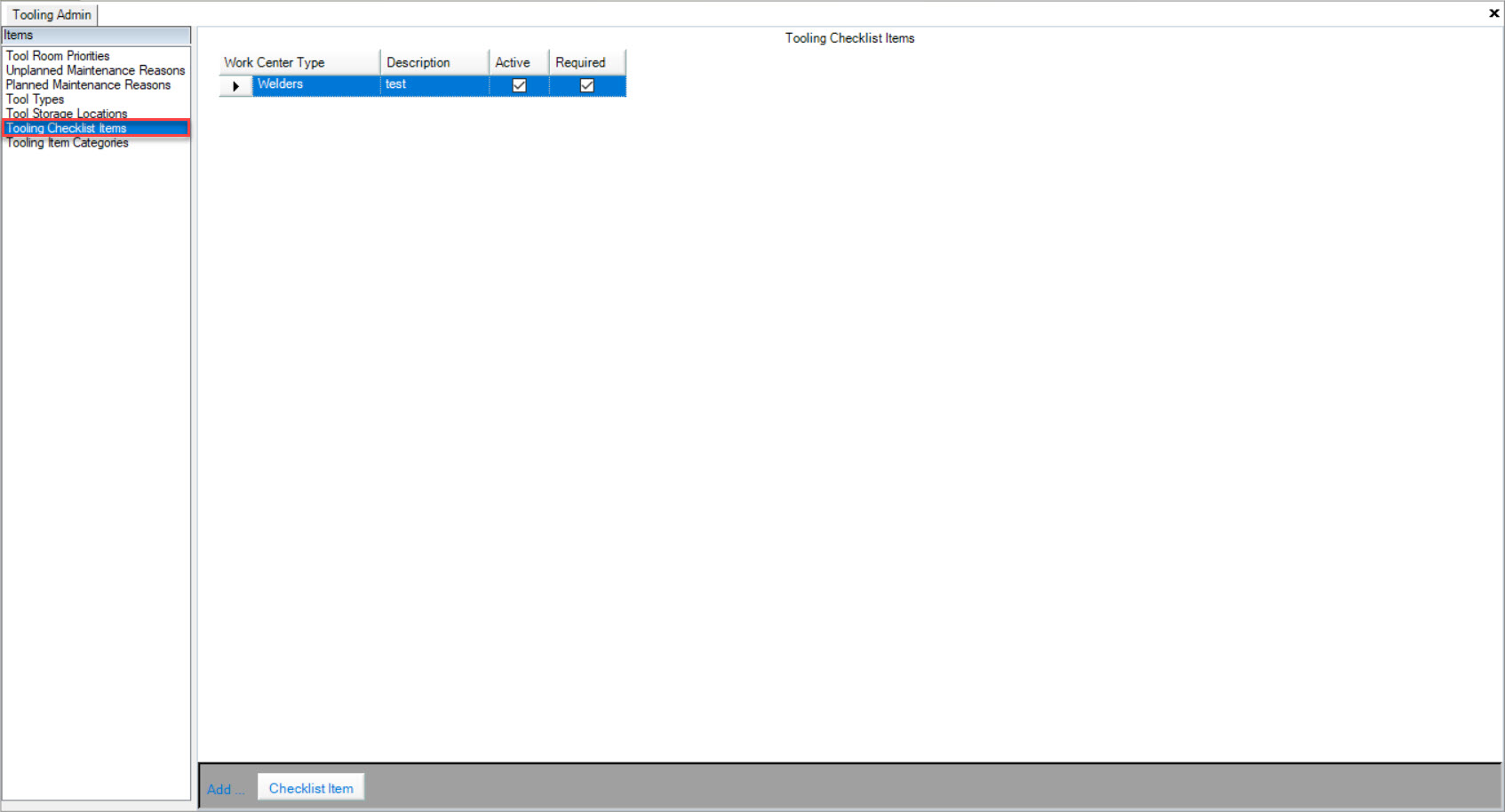
All of the available Tooling Checklist Items in the system will be displayed.

Here, users are able to add, edit, or delete Tooling Checklist Items.
Adding a Tooling Checklist Item¶
To add a Tooling Checklist Item, navigate to the  tab and click on the
tab and click on the ![]() icon. The Tooling Admin screen will be displayed.
icon. The Tooling Admin screen will be displayed.

Make sure to select Tooling Checklist Items located below the Items pane to the left of the screen.

Then, click on the  button located at the bottom of the screen.
button located at the bottom of the screen.
A new row will appear where users must select a Workcenter Type, enter in a Description, and select or de-select Active and Required.
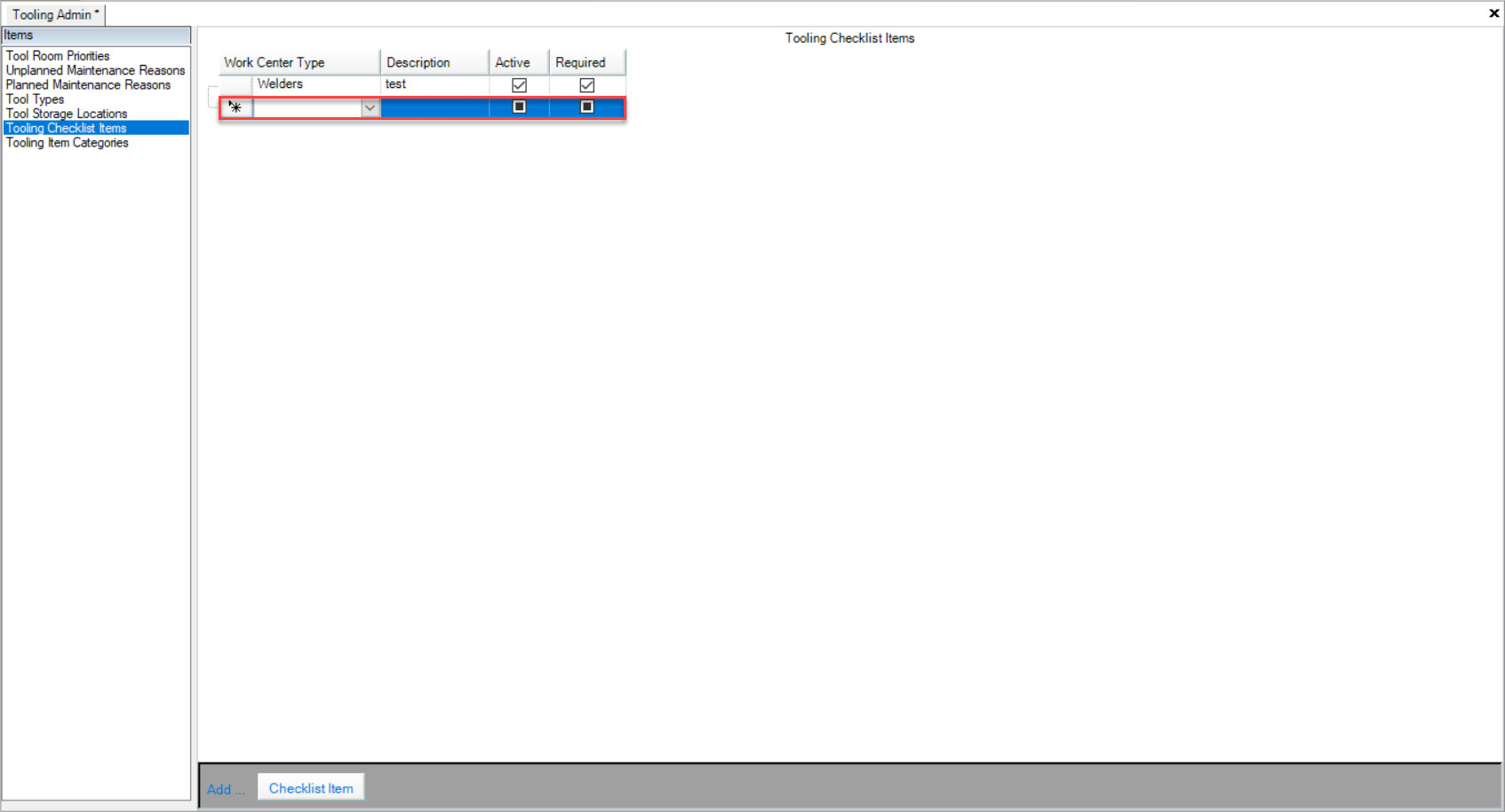
Make sure to save your changes before exiting the screen.
Editing a Tooling Checklist Item¶
To edit a Tooling Checklist Item, navigate to the  tab and click on the
tab and click on the ![]() icon. The Tooling Admin screen will be displayed.
icon. The Tooling Admin screen will be displayed.

Make sure to select Tooling Checklist Items located below the Items pane to the left of the screen.

Locate the Tooling Checklist Item you wish to edit and make the necessary changes using the available drop-down menu, textbox, and checkboxes.
Make sure to save your changes before exiting the screen.
Deleting a Tooling Checklist Item¶
To delete a Tooling Checklist Item, navigate to the  tab and click on the
tab and click on the ![]() icon. The Tooling Admin screen will be displayed.
icon. The Tooling Admin screen will be displayed.

Make sure to select Tooling Checklist Items located below the Items pane to the left of the screen.

Locate the Tooling Checklist Item you wish to delete and highlight the appropriate row. Use your Delete key and when the system prompts you, select Yes.
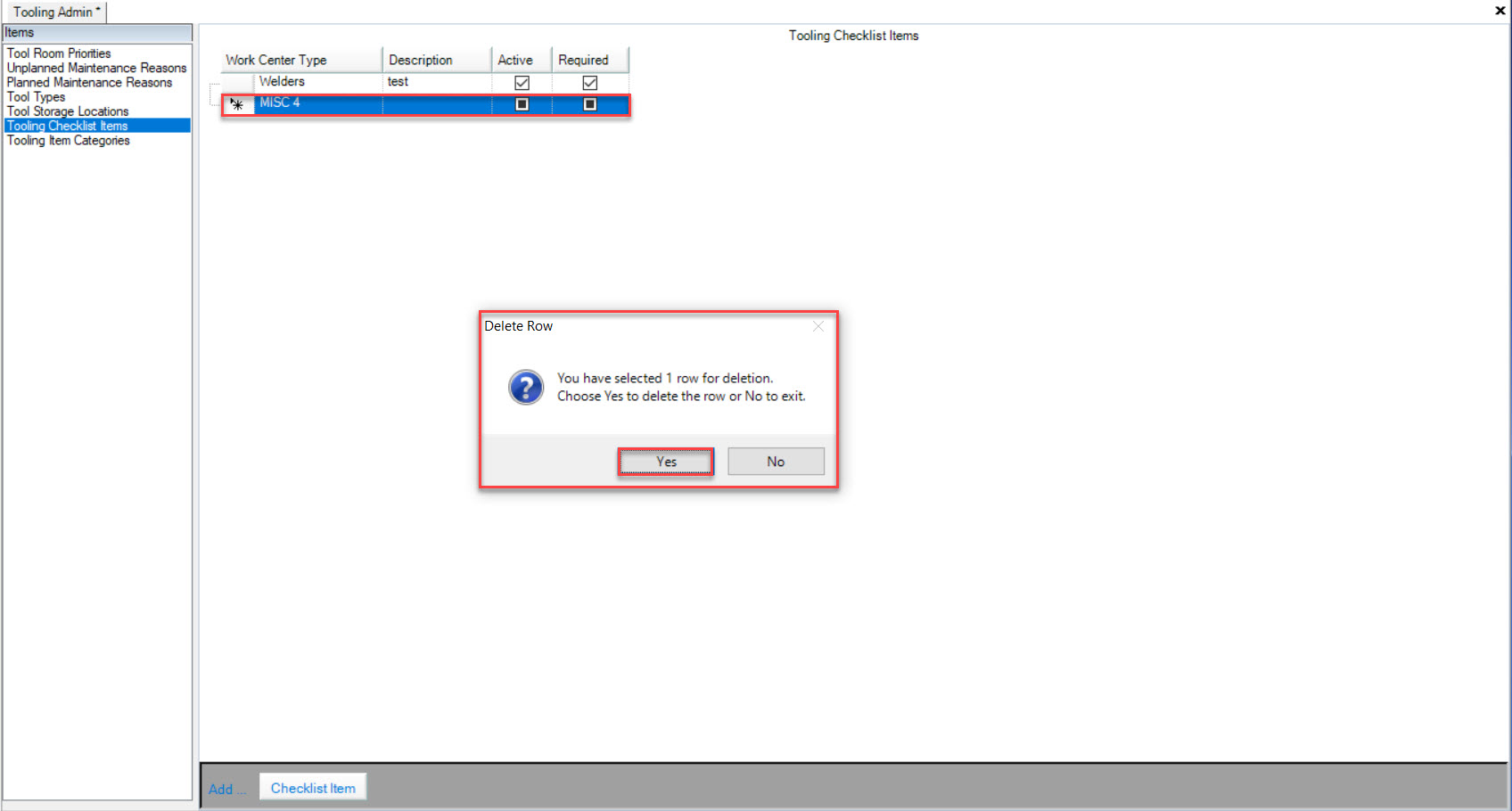
The selected Tooling Checklist Item will be deleted. Make sure to save your changes before exiting the screen.
Tooling Item Categories¶
Tooling Item Categories will appear as a drop-down option on the Tooling Item screen where users can select an option from the list. This field is optional.
To view Tooling Item Categories, navigate to the  tab and click on the
tab and click on the ![]() icon. The Tooling Admin screen will be displayed.
icon. The Tooling Admin screen will be displayed.

Make sure to select Tooling Item Categories located below the Items pane to the left of the screen.
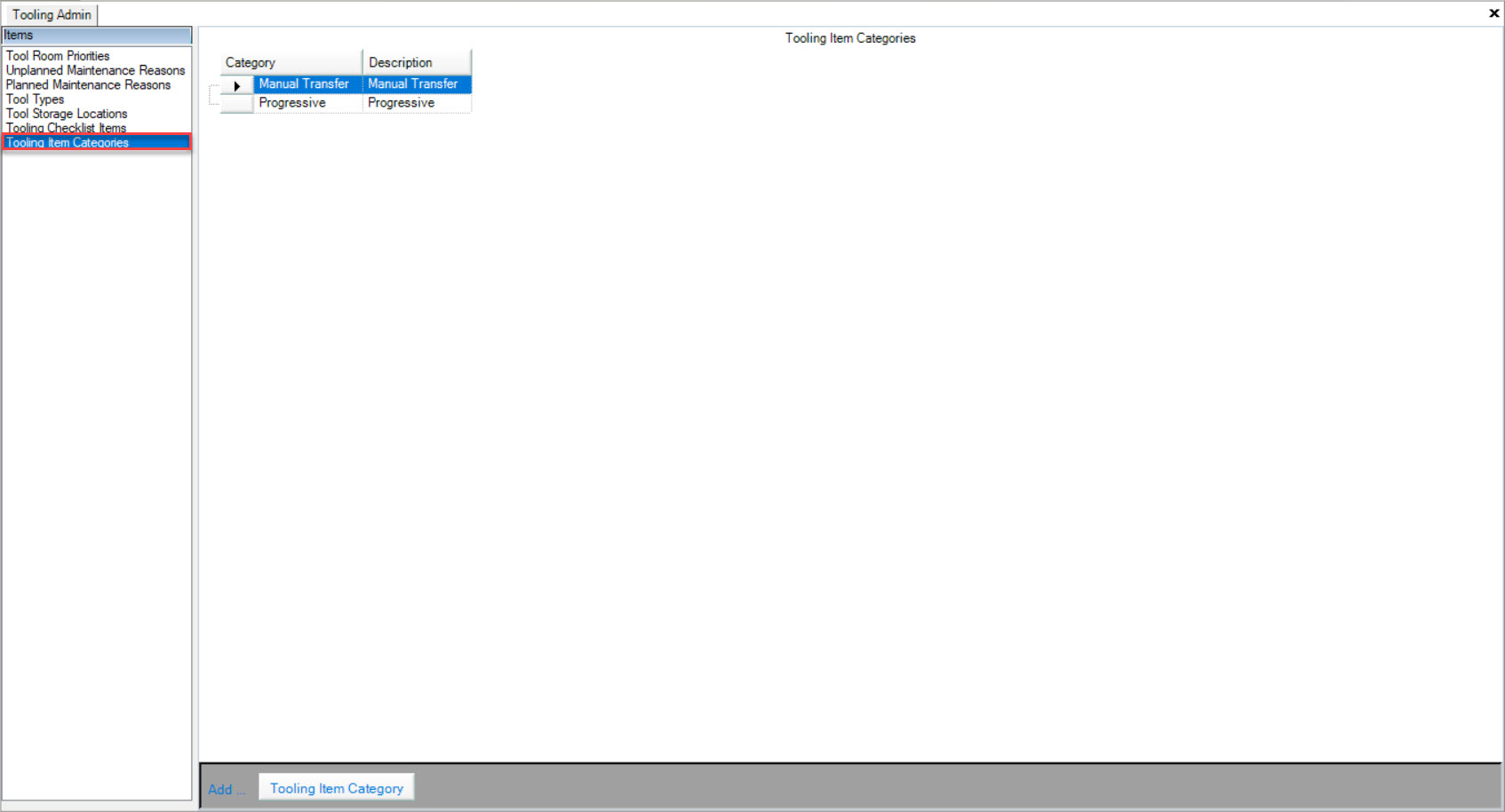
All of the available Tooling Item Categories in the system will be displayed.
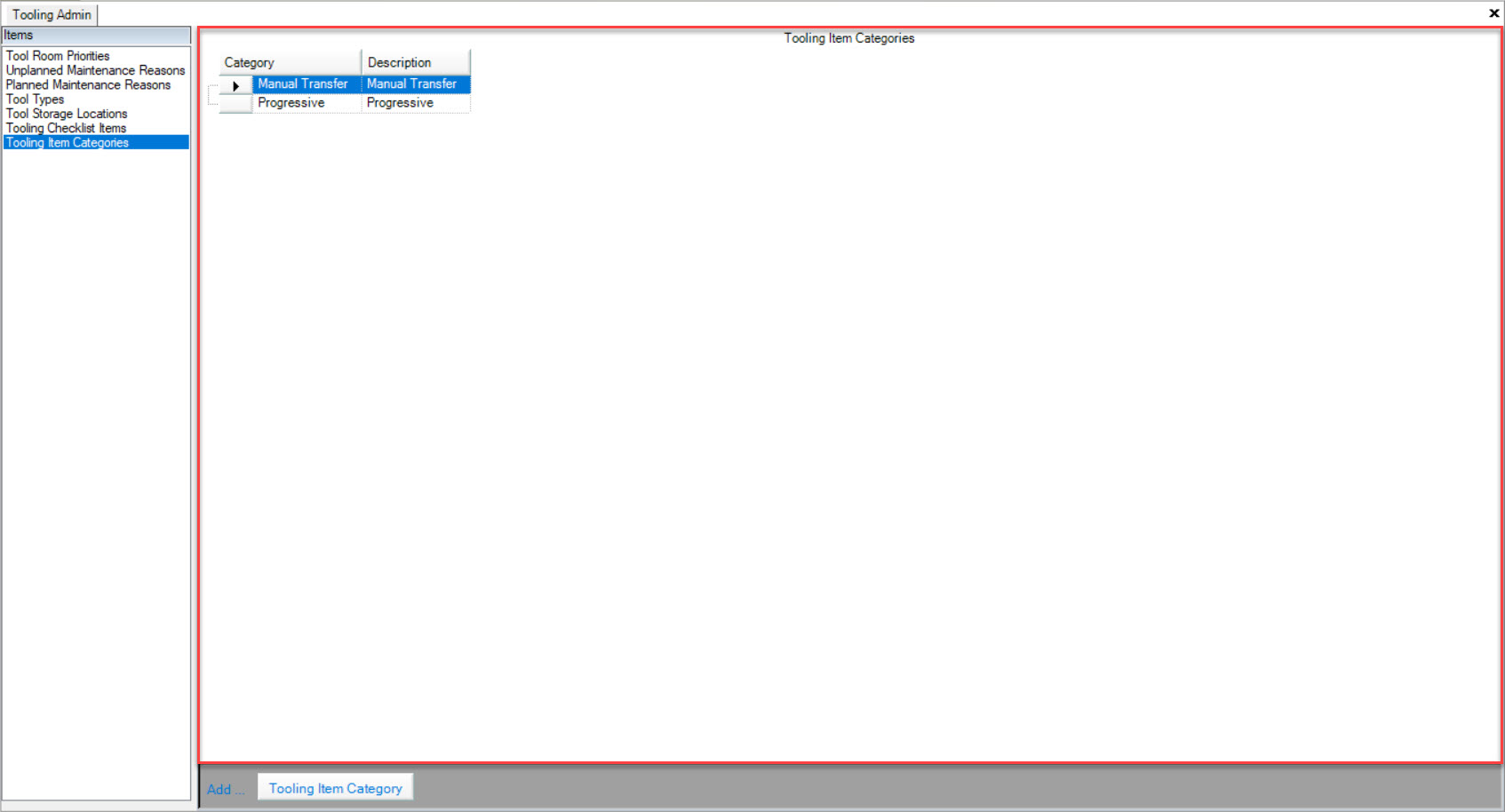
Here, users will be able to add, edit, or delete Tooling Item Categories.
Adding a Tooling Item Category¶
To add a Tooling Item Category, navigate to the  tab and click on the
tab and click on the ![]() icon. The Tooling Admin screen will be displayed.
icon. The Tooling Admin screen will be displayed.

Make sure to select Tooling Item Categories located below the Items pane to the left of the screen.

Then, click on the  button located at the bottom of the screen.
button located at the bottom of the screen.
A new row will appear where users must enter the Category and Description using the available textboxes.
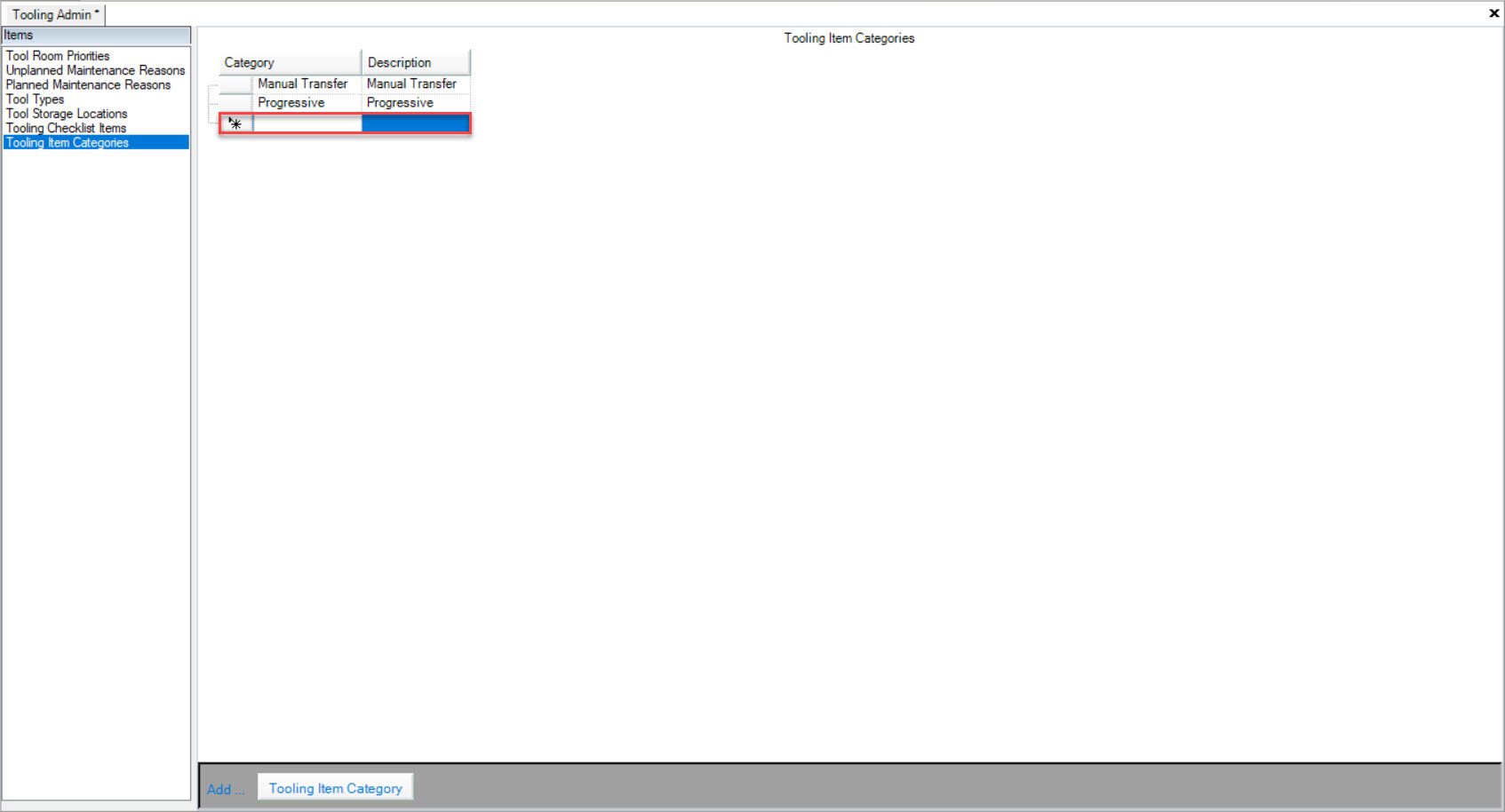
Make sure to save your changes before exiting the screen.
Editing a Tooling Item Category¶
To edit a Tooling Item Category, navigate to the  tab and click on the
tab and click on the ![]() icon. The Tooling Admin screen will be displayed.
icon. The Tooling Admin screen will be displayed.

Make sure to select Tooling Item Categories located below the Items pane to the left of the screen.

Locate the Tooling Item Category you wish to edit and make the necessary changes using the available textboxes.
Make sure to save your changes before exiting the screen.
Deleting a Tooling Item Category¶
To delete a Tooling Item Category, navigate to the  tab and click on the
tab and click on the ![]() icon. The Tooling Admin screen will be displayed.
icon. The Tooling Admin screen will be displayed.

Make sure to select Tooling Item Categories located below the Items pane to the left of the screen.

Locate the Tooling Item Category you wish to delete and highlight the appropriate row. Use your Delete key and when the system prompts you, select Yes.
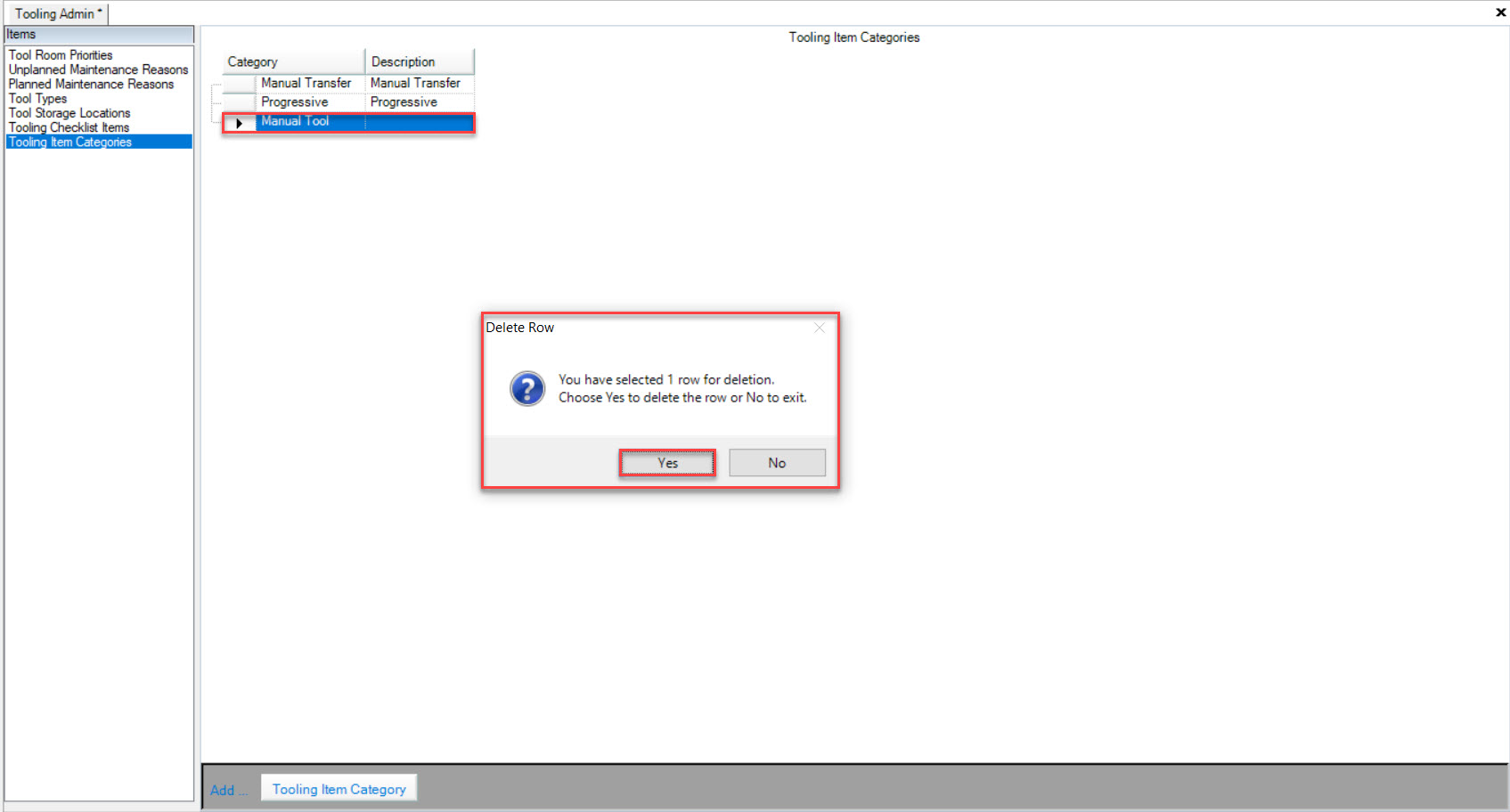
The selected Tooling Item Category will be deleted. Make sure to save your changes before exiting the screen.